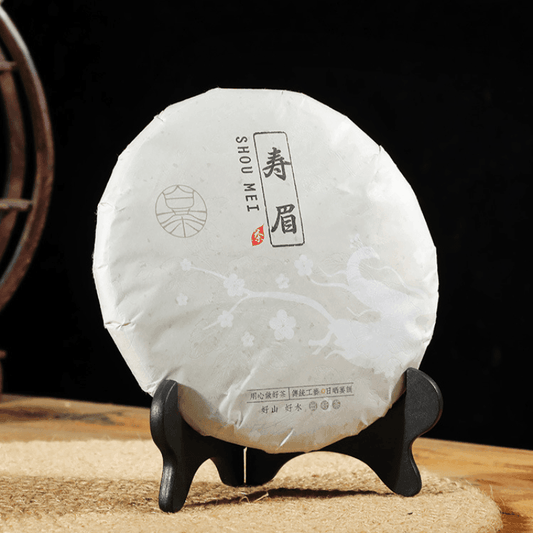Shou Mei Tea: The Mellow Charm of Time
—A Tasting Guide & Cultural Insight
1. Introduction to Shou Mei
Shou Mei (寿眉), a distinguished category of Chinese white tea, is primarily produced in Fuding and Zhenghe, Fujian Province. Made from larger leaves (one bud with three to four leaves) of the Da Bai (Big White) tea cultivar, it undergoes minimal processing—withering and drying—to preserve its natural character. Its name, meaning "Longevity Eyebrow," reflects its rustic, twisted leaves resembling an elder’s wise brows.
As a "tea of the people," Shou Mei is prized for its aging potential. Over time, its flavor evolves from fresh florals to sweet dates, herbs, and woody notes, earning it the title "the drinkable antique."
Key Features:
· Grades: Classified into Grade 1 and Grade 2 (formerly called "Gong Mei").
· Appearance: Large, slightly蓬松 (fluffy) leaves with a mix of gray-green and brown hues (turning amber with age).
· Flavor Profile: Young Shou Mei is light and floral; aged Shou Mei develops deep, honeyed richness.
2. Tasting Guide
1. Observing the Dry Leaves
· Young Tea (1-2 years): Leaves are vibrant green with silvery tips, stems flexible.
· Aged Tea (3+ years): Turns brownish-amber, leaves appear more wrinkled, with occasional white pekoe.
2. Aroma Profile
· Young Tea: Fresh hay, wildflowers, and a hint of melon sweetness.
· Aged Tea: Red dates, dried herbs, honey, and faint medicinal notes (top-quality aged Shou Mei may have chrysanthemum or ginseng-like aromas).
3. Brewing Methods
o Gaiwan (for clarity of flavor)
o Purple clay teapot (enhances mellowness)
o Boiling pot (ideal for aged Shou Mei)
o Young tea: 90-95°C (194-203°F)
o Aged tea: 100°C (212°F) to unlock deep flavors.
o First 3 infusions: Quick steeping (5-10 sec) for a crisp, sweet taste.
o Later infusions: Extend brewing time; aged Shou Mei can be boiled for 2-3 minutes for a richer texture.
4. Liquor Appreciation
· Young Tea: Pale gold, refreshing with a clean finish.
· Aged Tea: Amber to dark honey-colored, velvety smooth, with a lingering sweetness.
5. Examining the Wet Leaves
High-quality Shou Mei leaves remain pliable and intact after brewing. Young leaves show bright green, while aged ones turn copper-brown uniformly.
3. Aging & Health Benefits
· "Aged Like Fine Wine": Shou Mei’s higher stem and mature leaf content allow for slow oxidation, developing complexity over years.
· Storage Tips: Keep in cool, dark, and dry conditions (use ceramic jars or sealed bags; control humidity in tropical climates).
· Wellness Properties:
o Young Shou Mei: Rich in polyphenols & amino acids—refreshing, anti-inflammatory.
o Aged Shou Mei (5+ years): High in flavonoids—supports digestion, warms the body.
4. Cultural Significance
Shou Mei embodies Chinese tea philosophy—simplicity with depth. Its unpretentious appearance contrasts with its transformative aging journey, mirroring the Daoist ideal of "wu wei" (effortless mastery).
Perfect for:
· Daily drinking (budget-friendly yet flavorful)
· Collectors (ages beautifully for decades)
· Wellness seekers (gentle on the stomach)
Tasting Mantra:
"Young Shou Mei sings of spring; aged Shou Mei whispers wisdom. One sip carries seasons; one cup holds time."
Pro Tip: Beginners should start with 3-year-old Shou Mei for balance. Connoisseurs may seek wild-grown or high-mountain variants for superior aging potential.

![2011 Fuding White Tea Cake [Shou Mei] - YIQIN TEA HOUSE | yiqinteahouse.com | shou mei, tea, white tea](http://yiqinteahouse.com/cdn/shop/products/2011-fuding-white-tea-cake-shou-mei-yiqin-tea-house-yiqinteahouse-com-1.png?v=1723258830&width=533)

